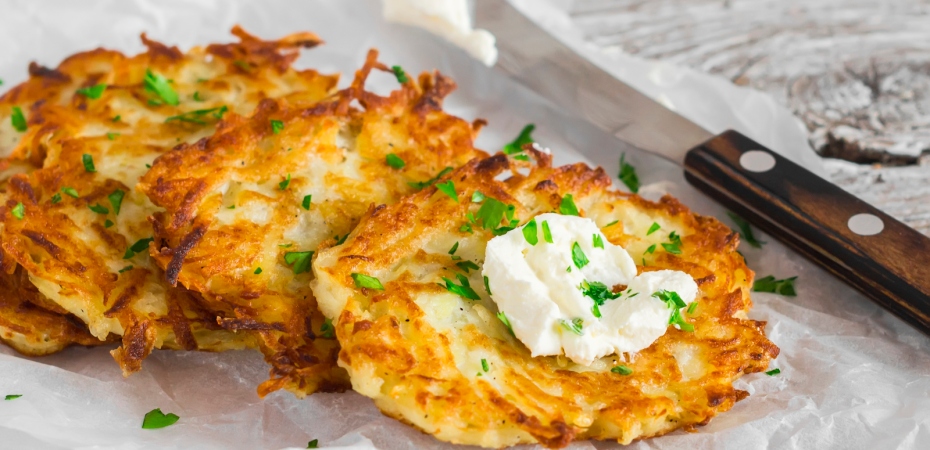By: Jackie Cutrona
This year, Hanukkah, the Jewish Festival of Lights, takes place from the evening of December 10th to the evening of December 18th. During these days, Jewish people all over the world celebrate the rededication of the Second Temple in Jerusalem by lighting candles, gathering (remotely) with friends and family, and, of course, eating lots of food. This food often includes—but is not limited to—latkes, gelt, matzo ball soup, and sufganiyot.
Latkes
Latkes are the most well-known Hanukkah food. Eaten by Ashkenazi (European-descended) Jews, these fried pancakes are a must-have. They are made from grated potatoes, flour or matzo meal (more on that later), onions, and eggs, then patted into a circular shape before being placed onto an oil-covered skillet. After being browned to a crip, they are flipped onto a plate and ready to eat. Latkes are served hot, often with sour cream or homemade applesauce.
Gelt
Gelt is the word for money in both Hebrew and Yiddish. But Hanukkah gelt isn’t the type of money one goes to the store with. Instead, it’s coins made from chocolate. Gelt can be eaten (obviously) or used when playing dreidel.
Dreidel is a fun, easy game played during the eight days of Hanukkah. While every family does it differently, the basic idea of the game is that there are tokens (ie. gelt, pennies, beans, whatever) in the center of the table and in front of every player. Each player must spin the four-sided spinning top (dreidel) to find out what they will do. The letters on the sides of the dreidel, also called sevivon, are associated with a word telling the player how many tokens to take. נ (nun) stands for “nisht” or “nothing,” ג (gimel) for “gantz” or “everything,” ה (hay) for “halb” or “half,” and ש (shin) for “shtel” or “put it (share).” In Israel, the letter ש is substituted for פ (peh) but this change has no effect on the game. It is simply there because, while the letters on other dreidels stand for נס גדול היה שם or “a great miracle happened there,” Israels must say נס גדול היה פה or “a great miracle happened here.”
Matzo Ball Soup
Matzo (matzah) ball soup is a staple in many Ashkenazi households, no matter the time of year. The soup itself usually contains carrots, celery, chicken breast, and onion, along with dill and a few other vegetables. These items are cut and diced, then put into a pot with chicken broth and water. While the soup simmers, the matzo balls are prepared. Matzo balls are made from a matzo ball mix, or, if you have more time, eggs, oil, baking powder, salt, and matzo meal. Now, you might be wondering, what is matzo, anyway? Is it a type of flour? The answer is, yes and no. Matzo meal is made from matzo crackers (unleavened bread made from flour, water, and olive oil) that have been finely ground. It is used in place of flour in some recipes but has a coarser texture.
Once the ingredients are mixed, it is placed in the fridge. This is to thicken the mixture and make it ready for being rolled into small balls. Once the balls are rolled, they are plopped into the broth. Then the chicken is taken out, shredded, and put back in. After another half hour or so, the soup is ready to eat.
Sufganiyot
Sufganiyot are perhaps the most delicious, and least well-known, of the Hanukkah foods. Sometimes referred to as jelly donuts, these deserts are round pockets of fried dough filled with anything from raspberry jam to Nutella or custard. Sufganiyot, while not often found in the US, are everywhere in Israel during the Hanukkah season. There are hundreds of types, ranging from beautifully decorated with chocolate and frosting to simply dusted with powdered sugar.
Sufganiyot dough is made from flour, sugar, yeast, oil, water, vanilla extract, and eggs. After mixing together the ingredients, the dough is let rise. The step after that depends on the recipe. Some call for adding the filling before frying, others say to inject the donut with it afterward. It does not matter. When the sufganiyot are fried and filled, they are dipped in sugar or decorated in whatever way one wants. Then, of course, they are eaten.

